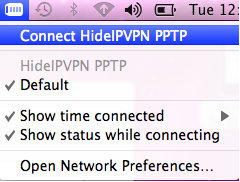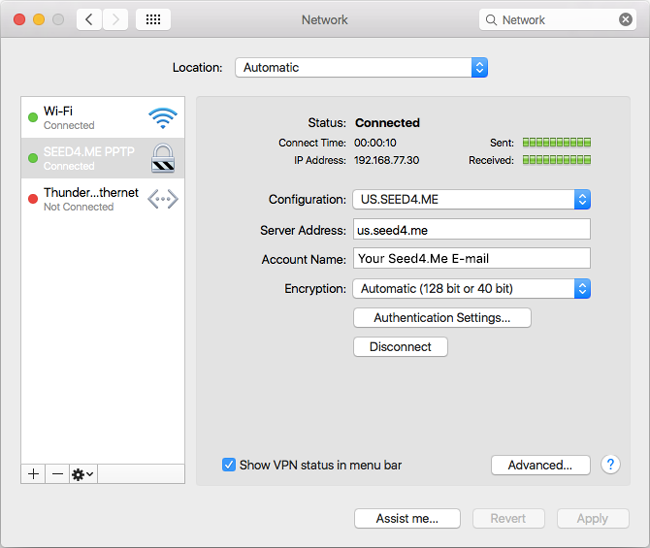equinux has introduced VPN Tracker 365, a multi-protocol VPN client designed for the upcoming macOS Big Sur.
Equinux CEO Till Schadde says it’s the first business VPN client for the Mac with support for macOS Big Sur, as well as Macs with Apple Silicon. VPN Tracker 365 supports all major VPN protocols, including IPsec, L2TP, OpenVPN and SonicWALL SSL, with PPTP VPN support coming later this year.
Below is short instruction what to do if you want to connect Windows SSTP VPN from MacOS. Prerequisites: Homebrew installed - see here. Run terminal and install sstp-client. Brew update brew install sstp-client In order to connect to your SSTP VPN with login. VPN Tracker is the #1 VPN client for Mac OS X. VPN Tracker supports over 300 VPN devices and lets you securely connect to any IPSec, PPTP, OpenVPN & L2TP VPN.
In Big Sur, Apple has changed the Mac’s security model, deprecating kernel extensions and other APIs relied on by low-level utilities and apps. This means some VPN apps designed for older macOS versions won’t work with the operating system update.
Schadde says VPN Tracker 365 is the first multi-VPN solution to support the new System Extension architecture and implements custom networking protocols using new networking application programming interfaces in macOS Big Sur. It’s available today as an Universal app for both Intel Macs as well as upcoming Macs with Apple Silicon. VPN Tracker 365 supports a wide range of macOS releases, including OS X 10.11 El Capitan, macOS 10.12 Sierra, macOS 10.13 High Sierra, macOS 10.14 Mojave, macOS 10.15 Catalina and macOS 11 Big Sur.
The new version of VPN Tracker 365 is available as a public beta starting today, the final release will ship later this month. The all new VPN Tracker 365 is a free update for existing VPN Tracker 365 customers, new customers can sign up for VPN Tracker 365 from vpntracker.com starting at US$99 annually.

Objective
This document explains the procedure to use the MAC operating system's default VPN client to setup a PPTP connection over VPN Tunnel for a VPN Client Access. Suppose if there are two sites Site A and Site B. Both have a VPN Tunnel established between them. Both use the same RV220W device. A client user credential with username and password is set on Site B. Then the document explains the procedure to access Site B from Site A over the Tunnel in the MAC OS environment.
Applicable Devices
• RV220W
• RV120W


VPN Connection Setup
VPN User Set at Remote Site
A VPN user for PPTP is already set up on the Remote Site. The username being test123 and password being test123123.
VPN Connection Creation
Mac Pptp Vpn Client
Step 1. Click the + sign to create a new connection.
Step 2. Choose VPN from the Interface drop-down list as the desired connection to be set is VPN.
Step 3. Choose PPTP from the VPN Type drop-down list; as PPTP is the type of VPN connection to be set.
Step 4. Enter any name for the connection in the Service Name field. In the example the name Test is entered.
Step 5. Click Create to create the VPN connection.
Configuration of the VPN Connection
Step 1. Click the connection Test created from the connections displayed to configure the settings.
Step 2. The Configuration drop-down list gives information about any previous configuration settings saved for any connection. If it is required to save the configuration settings of the connection, then choose Add Configuration option from the Configuration drop-down list. In this case it is not required to save the configuration settings and therefore the Default option is chosen.
Step 3. Enter the IP Address of the server in the Server Address field. The Server Address is the Remote Local Area Network IP Address of the device on end point of the tunnel. Here in this case the Local Local Area Network IP Address is 192.168.10.1 and Remote Local Area Network Address is 192.168.1.1.
Step 4. Enter the appropriate account user name in the Account Name field. Here the Account Name is the username (test123).
Step 5. Click Authentication Settings. A dialog box that allows the user to enter a password appears.
Step 6. Click the Password radio button as the user authentication method is set as password. Then enter the password in the corresponding field. In this example, the password is test123123. This password is for the account user.
Vpn Client For Mac
• RSA SecurID — There is a portable device sometimes given to the users which generates a numeric value. If the authentication mechanism is set by the server is through this numeric value then this option is used.
• Certificate — The server sometimes issues authentication certificates to the user. If the user has downloaded certificate present then those can be uploaded for authentication. Click the Select button to choose the appropriate certificate downloaded.
• Kerberos — Kerberos is a security protocol used for user authentication. The user sends the Account User Name entered to the server. The server authenticates the user and sends the user a session key and a Ticket which basically has information about the user's ID, user's Network Address and session validity period.
• CryptoCard — The CryptoCard method will inform the user a password from the server each time the user logs into the server.
Step 7. Click Ok.
Step 8. To make sure all the traffic is being sent through VPN, Click the Advanced.
Step 9. Check the Send all traffic over VPN check box. This will enable all the packets to go through the VPN connection.
Step 10. Click Ok.
Step 11. Click Apply button to apply the configurations made to the connection.
Step 12. Click Connect to connect.
